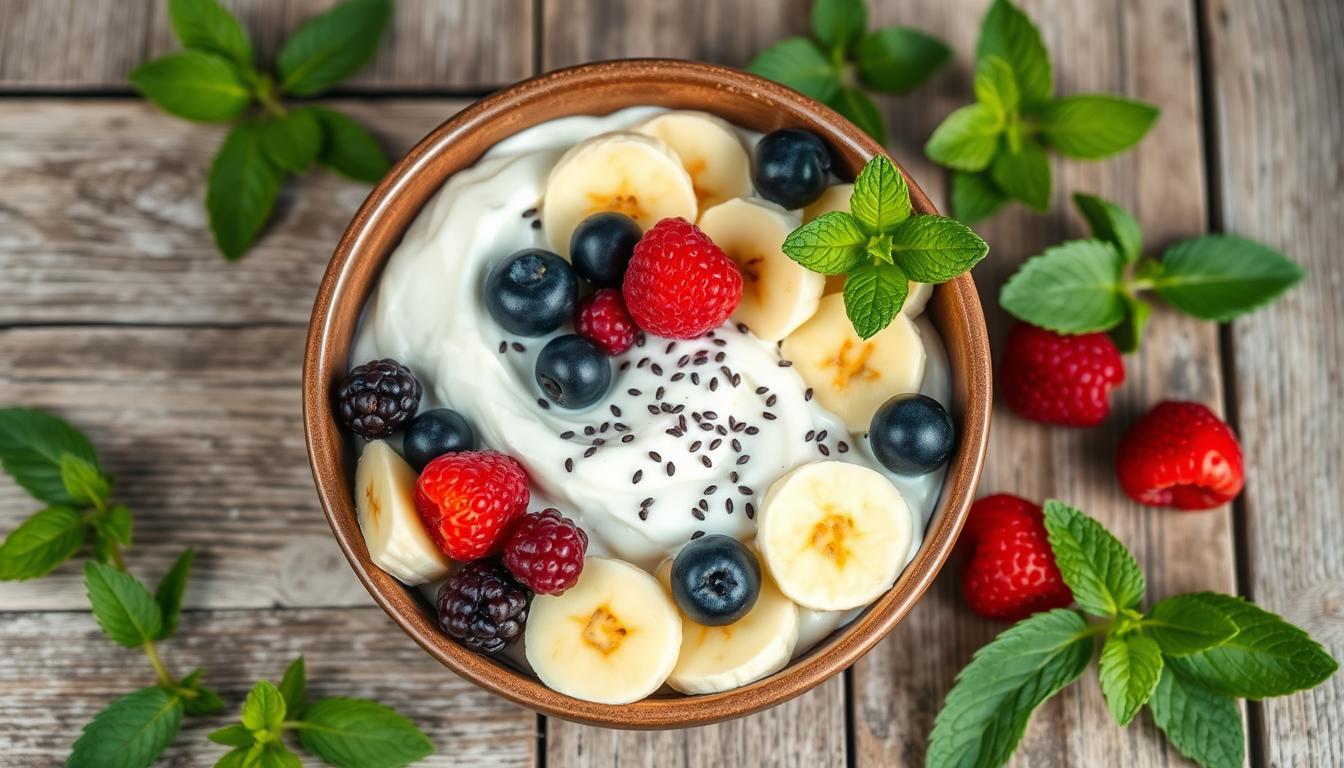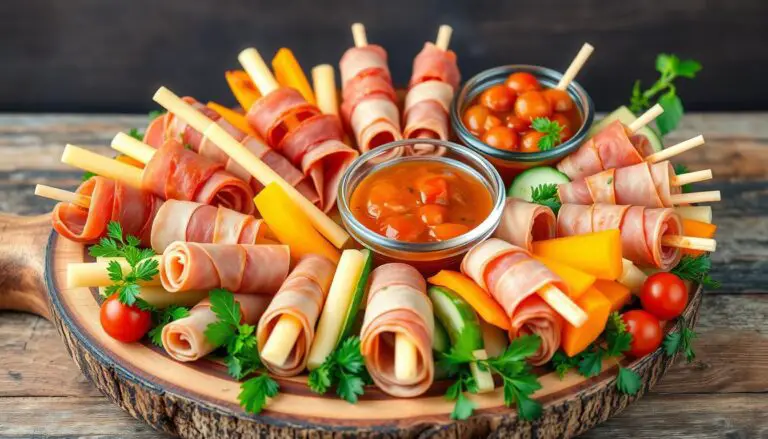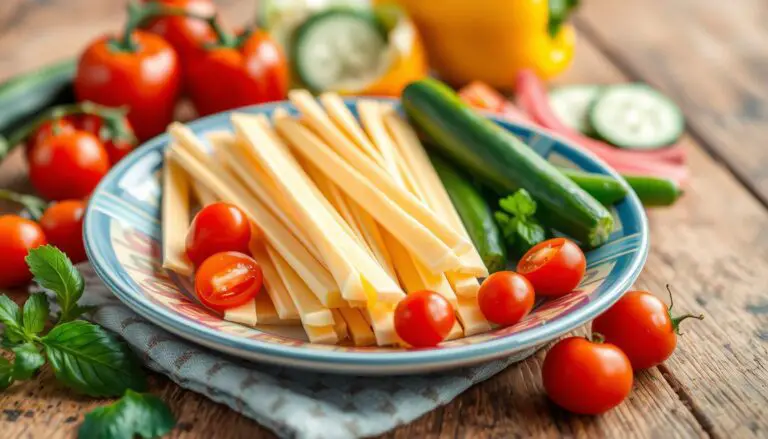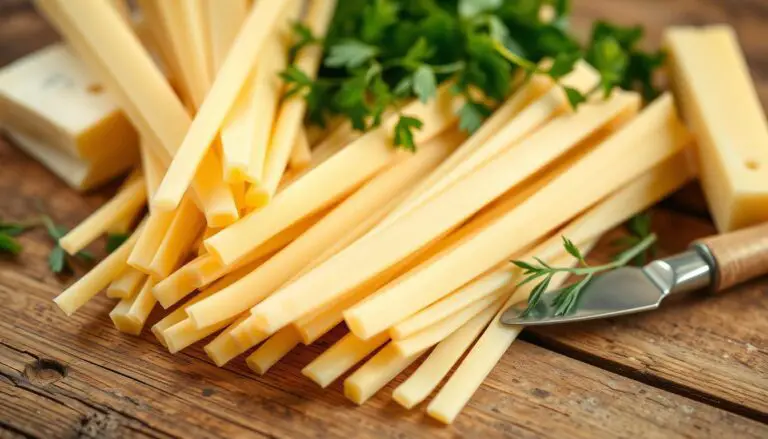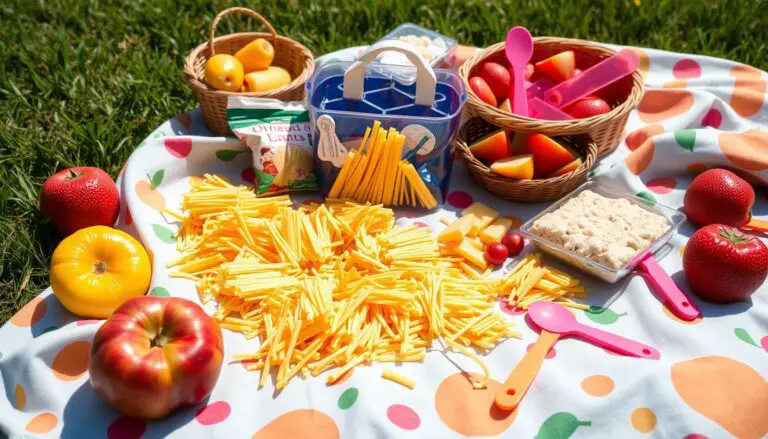How to Eat Cottage Cheese: Popular Serving Methods
Cottage cheese is a nutritious dairy product that’s making a comeback. It’s packed with 14 grams of protein in a 4-ounce serving1. This makes it great for diets like low-carb and Weight Watchers. It also has about 3-6 grams of carbs per 1/2 cup1, which is good for those watching their carb intake.
This article will show you many cottage cheese recipes. You’ll learn how to add healthy cottage cheese meals to your day. From mixing it with fruits to using it in savory dishes, there are over 50 ways to enjoy it1. Let’s explore the best ways to add cottage cheese to your diet for a nutritional boost!
Key Takeaways
- Cottage cheese is a rich source of protein, making it an ideal addition to various diets.
- It contains minimal carbs, perfect for low-carb meal plans.
- There are myriad cottage cheese recipes, ranging from sweet to savory.
- Cottage cheese pairs well with fruits, enhancing flavor and nutrition.
- This versatile ingredient can easily substitute ricotta cheese and sour cream in recipes.
What is the most common way to eat cottage cheese?
Cottage cheese is loved for its many uses in cooking. It’s often mixed with fruits or veggies. This mix not only tastes great but also adds nutrients, making it a hit with those who care about health. For a quick, protein-packed meal, try cottage cheese breakfast ideas.
Enjoying Cottage Cheese with Fresh Fruits
Fruits like bananas, berries, and peaches are great with cottage cheese. Their sweetness pairs well with cottage cheese’s mild taste, adding vitamins. Cottage cheese has about 23 grams of protein per cup, which is great for protein lovers2.
For a healthy breakfast or snack, mix cottage cheese with fresh fruits. It’s a refreshing and nutritious choice.
Pairing Cottage Cheese with Vegetables
Vegetables are also a great match for cottage cheese. You can serve it with fresh herbs or use it as a dip for veggies like celery and carrots. This adds flavor and fiber to your diet. Cottage cheese has 176 milligrams of calcium per cup, helping meet daily calcium needs2.
Its mild, creamy taste goes well with both sweet and savory foods. This opens up a world of culinary possibilities. You can choose from different fat levels, from full-fat to fat-free, for healthier options3.
Savory Cottage Cheese Dishes
Savory cottage cheese dishes are full of tasty flavors and good for you. You can make a satisfying meal by turning cottage cheese into a flavorful bowl. Add different ingredients to make it even better for taste and health.
Creating Savory Bowls with Cottage Cheese
To make a tasty bowl, top cottage cheese with hard-boiled eggs, cherry tomatoes, and fresh herbs. This mix gives you 23 grams of protein per serving, great for those watching their protein intake4. Adding avocado and pistachios for healthy fats makes it rich and tasty, all for about 307 calories4.
Try adding grilled veggies or olives to make it your own. These savory cottage cheese recipes are quick, ready in under an hour, perfect for when you’re in a rush5.
Cottage Cheese as a Base for Dips
Cottage cheese is a great base for dips, offering a creamy texture. Mix it with garlic, herbs, or lemon juice for a tasty dip. It’s a healthier option than regular creamy dips, adding protein to your snack or party food. This makes it easy to find new ways to use cottage cheese, pleasing everyone’s taste6.
Whether you’re hosting a party or just want a snack, cottage cheese dips are a hit. They’re full of flavor and help keep your diet balanced.
Sweet Cottage Cheese Recipes
Sweet cottage cheese recipes are a great way to add a bit of sweetness to your meals. Mixing cottage cheese with honey is a tasty choice that also increases protein. You can top cottage cheese with fruits and nuts for a satisfying snack or breakfast.
Cottage Cheese with Honey and Nuts
Adding honey to cottage cheese makes for a simple yet delicious treat. Just a little honey can make a big difference. Sprinkle some chopped nuts on top for extra flavor and texture.
This combo not only tastes good but also packs a protein punch. A half-cup of cottage cheese has about 14 grams of protein7. You can try different recipes, like the Whipped Honey Cottage Cheese Parfait, to enjoy this sweet mix in new ways7.
Cottage Cheese Pancakes for a Sweet Start
Cottage cheese pancakes are a great breakfast option. They’re fluffy, high in protein, and easy to make. You can whip them up in under 10 minutes8.
Top them with maple syrup, fresh berries, or yogurt for extra flavor. Sweet cottage cheese recipes often feature these pancakes as a tasty and healthy breakfast choice.
| Recipe | Key Ingredient | Protein Content | Calories |
|---|---|---|---|
| Cottage Cheese with Honey | Cottage cheese, Honey, Nuts | 14g | Varies based on toppings |
| Cottage Cheese Pancakes | Cottage cheese, Oats, Eggs | Varies, high protein | Approx. 210 per serving |
Cottage Cheese Breakfast Ideas
Cottage cheese is a great choice for a healthy breakfast. It’s full of protein and can be used in many ways. Adding cottage cheese to your morning can make your meals more satisfying.
High-Protein Breakfast Bowls
High-protein breakfast bowls are a fantastic way to enjoy cottage cheese. A half-cup has 14 grams of protein, making it a great start to the day9. You can top it with fruits, nuts, and granola for extra flavor and texture. Using 2% low-fat cottage cheese adds creaminess, but full-fat or non-fat works too9.
Cottage Cheese Smoothies for a Quick Meal
Cottage cheese smoothies are a quick and healthy meal. Blend it with fruits like bananas or spinach for a creamy drink. It’s easy to make and you can change it up to taste.

| Breakfast Bowl Ingredients | Protein Content (grams) | Calories |
|---|---|---|
| Cottage cheese (1/2 cup) | 14 | 90 |
| Banana (1 medium) | 1.3 | 105 |
| Almonds (1 oz) | 6 | 164 |
| Granola (1/4 cup) | 3 | 120 |
Adding cottage cheese to your breakfast, whether in bowls or smoothies, boosts your protein and nutrition10.
Healthy Cottage Cheese Meals
Cottage cheese is great for making healthy meals. It’s a good substitute for ricotta, adding creaminess without extra fat. It’s perfect for dishes like lasagna, boosting protein and nutrients.
Using Cottage Cheese as a Ricotta Substitute
Cottage cheese is a better choice than ricotta in many recipes. It blends well to be creamy. A 1-cup serving of cottage cheese has 163 calories and 28 grams of protein, which is over half of what we need daily11.
This change adds flavor and important nutrients like calcium and phosphorus11.
Incorporating Cottage Cheese into Pasta Dishes
Cottage cheese makes pasta dishes richer and more protein-packed. For example, Cottage Cheese Mac and Cheese has 23 grams of protein and only 399 calories12. It’s quick to make, perfect for weeknights12.
Choosing high-fiber macaroni noodles makes the meal even better12. Using cottage cheese keeps the dish creamy without the extra fat.
| Meal Type | Cottage Cheese as a Ricotta Substitute | Cottage Cheese in Pasta Dishes |
|---|---|---|
| Calories per cup | 163 | 399 (in Mac and Cheese) |
| Protein content | 28g | 23g (in Mac and Cheese) |
| Preparation time | Varies | Under 30 minutes |
| Dietary Benefits | Low-fat, nutrient-rich | Protein-rich, balanced with fiber |
Cottage Cheese Snacks
Cottage cheese snacks are a great way to stay full all day. They are quick, easy, and packed with protein. This makes them perfect for those looking for healthy options.
Mixing Cottage Cheese with Nut Butters
Mixing cottage cheese with nut butters makes a tasty, protein-rich snack. It adds healthy fats and boosts flavor. For example, mixing 1 cup of low-fat cottage cheese with almond butter gives you about 22 grams of protein.
Spreading Cottage Cheese on Whole Grain Toast
Spreading cottage cheese on whole grain toast is another excellent choice. Adding tomatoes or avocado makes it even more satisfying. For instance, avocado toast with cottage cheese has about 352 calories and lots of protein. It’s a healthy snack that tastes great.

| Snack | Calories | Protein (g) | Fat (g) | Carbs (g) |
|---|---|---|---|---|
| Cottage Cheese with Nut Butter | Approximately 300 | 22 | 16 | 18 |
| Cottage Cheese on Whole Grain Toast | 352 | 17 | 17 | 36 |
| Protein-Packed Ranch Dip | 43 | 6 | 1.5 | 3 |
Cottage Cheese Toppings to Enhance Flavor
Choosing the right toppings is key to enjoying cottage cheese. Different toppings can make simple cottage cheese into a tasty meal. Herbs, spices, fruits, and veggies can make cottage cheese more enjoyable.
Exploring Creative Topping Combinations
Mixing cottage cheese with unique toppings can lead to delightful culinary surprises. Consider blending your cottage cheese with:
- Sliced Avocado – for creaminess and healthy fats.
- Chopped Vegetables – like bell peppers or cucumber for crunch.
- Spicy Sriracha – adding a kick to your dish.
- Fresh Fruits – such as berries or peaches for sweetness.
- Nuts and Seeds – like walnuts or chia seeds for added texture and nutrition.
These creative cottage cheese recipes unlock a variety of flavor profiles. You can aim for sweet, savory, or spicy combinations.
Additions for Extra Nutrition Boost
Incorporating superfoods and nutritious toppings to your cottage cheese can provide additional health benefits. Options may include:
| Topping | Nutritional Benefit |
|---|---|
| Flaxseeds | Rich in omega-3 fatty acids |
| Greek Yogurt | Boosts protein content |
| Honey | Natural sweetener with antioxidants |
| Cinnamon | May help regulate blood sugar levels |
Incorporating these toppings transforms cottage cheese into a power-packed meal. It meets both taste and nutrition needs. Cottage cheese is highly versatile, offering a canvas for an array of toppings that enhance its flavor and health benefits.
Storage and Freshness of Cottage Cheese
Keeping cottage cheese fresh is key. It should be tightly sealed and stored in the fridge. Unopened cottage cheese stays good in the fridge. Once opened, it can last 7 to 10 days if sealed well. These tips help keep cottage cheese fresh and reduce waste1617.
How to Properly Store Cottage Cheese
To keep cottage cheese fresh, follow these steps:
- Store it in an airtight container or keep the original packaging tightly sealed.
- Place the cottage cheese in the coldest part of your refrigerator, avoiding the door.
- Consider storing the container upside down to reduce the risk of mold forming on the surface.
For longer storage, cottage cheese can be frozen for up to three months. Dry-curd cottage cheese, also known as farmer’s cheese, freezes better than creamier types16.
Understanding Shelf Life after Opening
The shelf life of cottage cheese is important for its safety and taste. After opening, cottage cheese can last from one week to ten days. Look out for signs of spoilage like a watery mix, mold, or a sour smell17. Always check these signs to avoid bad cottage cheese.
By following these tips, your cottage cheese will stay a healthy and tasty part of your meals.
Conclusion
Cottage cheese is a great food for your health. It has about 14 grams of protein in half a cup and only 100-120 calories. This makes it a tasty, low-calorie choice for many diets18.
It’s also packed with calcium and B vitamins. You can enjoy it in many ways, from sweet to savory. This adds flavor and health benefits to your meals19.
Cottage cheese is easy to use in cooking. It’s perfect for protein-rich breakfasts or tasty snacks. It’s also low in carbs, making it good for diets like keto or vegetarian18.
There are even dairy-free options for those who can’t have regular cottage cheese. This means everyone can enjoy its delicious and healthy benefits.
Adding cottage cheese to your meals makes them more nutritious. It also makes them creamier, like in pasta or pancakes. Try different ways to eat cottage cheese and see how it can help you live a healthier, tastier life19.

